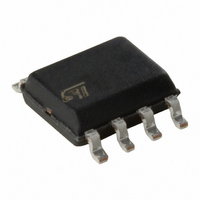TS4871ID STMicroelectronics, TS4871ID Datasheet - Page 21

TS4871ID
Manufacturer Part Number
TS4871ID
Description
IC AMP AUDIO PWR 1W MONO 8SOIC
Manufacturer
STMicroelectronics
Type
Class ABr
Datasheet
1.TS4871IST.pdf
(28 pages)
Specifications of TS4871ID
Output Type
1-Channel (Mono)
Max Output Power X Channels @ Load
1W x 1 @ 8 Ohm
Voltage - Supply
2.5 V ~ 5.5 V
Features
Depop, Standby, Thermal Protection
Mounting Type
Surface Mount
Package / Case
8-SOIC (3.9mm Width)
Operational Class
Class-AB
Audio Amplifier Output Configuration
1-Channel Mono
Output Power (typ)
1x1@8OhmW
Audio Amplifier Function
Speaker
Total Harmonic Distortion
0.15@8Ohm@250mW%
Single Supply Voltage (typ)
3/5V
Dual Supply Voltage (typ)
Not RequiredV
Supply Current (max)
8@5VmA
Power Supply Requirement
Single
Unity Gain Bandwidth Product (typ)
2MHz
Rail/rail I/o Type
Rail to Rail Output
Power Supply Rejection Ratio
75dB
Single Supply Voltage (min)
2.5V
Single Supply Voltage (max)
5.5V
Dual Supply Voltage (min)
Not RequiredV
Dual Supply Voltage (max)
Not RequiredV
Operating Temp Range
-40C to 85C
Operating Temperature Classification
Industrial
Mounting
Surface Mount
Pin Count
8
Package Type
SOIC
Product
Class-A
Output Power
1 W
Thd Plus Noise
0.15 %
Operating Supply Voltage
3 V, 5 V
Supply Current
6 mA
Maximum Operating Temperature
+ 85 C
Mounting Style
SMD/SMT
Audio Load Resistance
8 Ohms
Input Offset Voltage
- 0.3 V to + 0.3 V
Input Signal Type
Single
Minimum Operating Temperature
- 40 C
Output Signal Type
Differential
Supply Type
Single
Supply Voltage (max)
5.5 V
Supply Voltage (min)
2.5 V
Lead Free Status / RoHS Status
Lead free / RoHS Compliant
Other names
497-2290-5
Available stocks
Company
Part Number
Manufacturer
Quantity
Price
Part Number:
TS4871ID
Manufacturer:
ST
Quantity:
20 000
Company:
Part Number:
TS4871IDT
Manufacturer:
st
Quantity:
2 486
Part Number:
TS4871IDT
Manufacturer:
ST
Quantity:
20 000
Hypothesis :
(Vout and Iout)
• Supply voltage is a pure DC source (Vcc)
Regarding the load we have:
and
and
Then, the average current delivered by the supply
voltage is:
The power delivered by the supply voltage is
Psupply = Vcc Icc
Then, the power dissipated by the amplifier is
Pdiss = Psupply - Pout (W)
and the maximum value is obtained when:
Remark : This maximum value is only depending
on power supply voltage and load values.
The efficiency is the ratio between the output
power and the power supply
• Voltage and current in the load are sinusoidal
and its value is:
Power dissipation and efficiency
P
di ss
=
Pdiss
2 2 Vcc
---------------------- P
V
I
CC
P
O UT
=
R
max
O U T
I
AVG
OU T
AVG
L
----------------------- - =
Psup ply
= V
--------------------- - = 0
P
Pdiss
=
(W)
O UT
P
= 2
=
V
---------------------- (W)
OU T
2
PEAK
OU T
V
---------------- - (A)
Vcc
P E A K
2
2 R
OU T
R
V
------------------- - (A)
R
P E A K
L
L
sin t (V)
2
L
–
R
---------------------- -
2
(
P
4V
L
W
V
O UT
P E A K
)
C C
(W)
The maximum theoretical value is reached when
Vpeak = Vcc, so
Two capacitors are needed to bypass properly the
TS4871, a power supply bypass capacitor Cs and
a bias voltage bypass capacitor Cb.
Cs has especially an influence on the THD+N in
high frequency (above 7kHz) and indirectly on the
power supply disturbances.
With 100µF, you can expect similar THD+N
performances like shown in the datasheet.
If Cs is lower than 100µF, in high frequency
increases, THD+N and disturbances on the power
supply rail are less filtered.
To the contrary, if Cs is higher than 100µF, those
disturbances on the power supply rail are more
filtered.
Cb has an influence on THD+N in lower frequency,
but its function is critical on the final result of PSRR
with input grounded in lower frequency.
If Cb is lower than 1µF, THD+N increase in lower
frequency (see THD+N vs frequency curves) and
the PSRR worsens up
If Cb is higher than 1µF, the benefit on THD+N in
lower frequency is small but the benefit on PSRR
is substantial (see PSRR vs. Cb curve : fig.12).
Note that Cin has a non-negligible effect on PSRR
in lower frequency. Lower is its value, higher is the
PSRR (see fig. 13).
Pop and Click performance is intimately linked
with the size of the input capacitor Cin and the bias
voltage bypass capacitor Cb.
Size of Cin is due to the lower cut-off frequency
and PSRR value requested. Size of Cb is due to
THD+N and PSRR requested always in lower
frequency.
Moreover, Cb determines the speed that the
amplifier turns ON. The slower the speed is, the
softer the turn ON noise is.
The charge time of Cb is directly proportional to
Decoupling of the circuit
Pop and Click performance
---- - = 78.5%
4
TS4871
21/28












